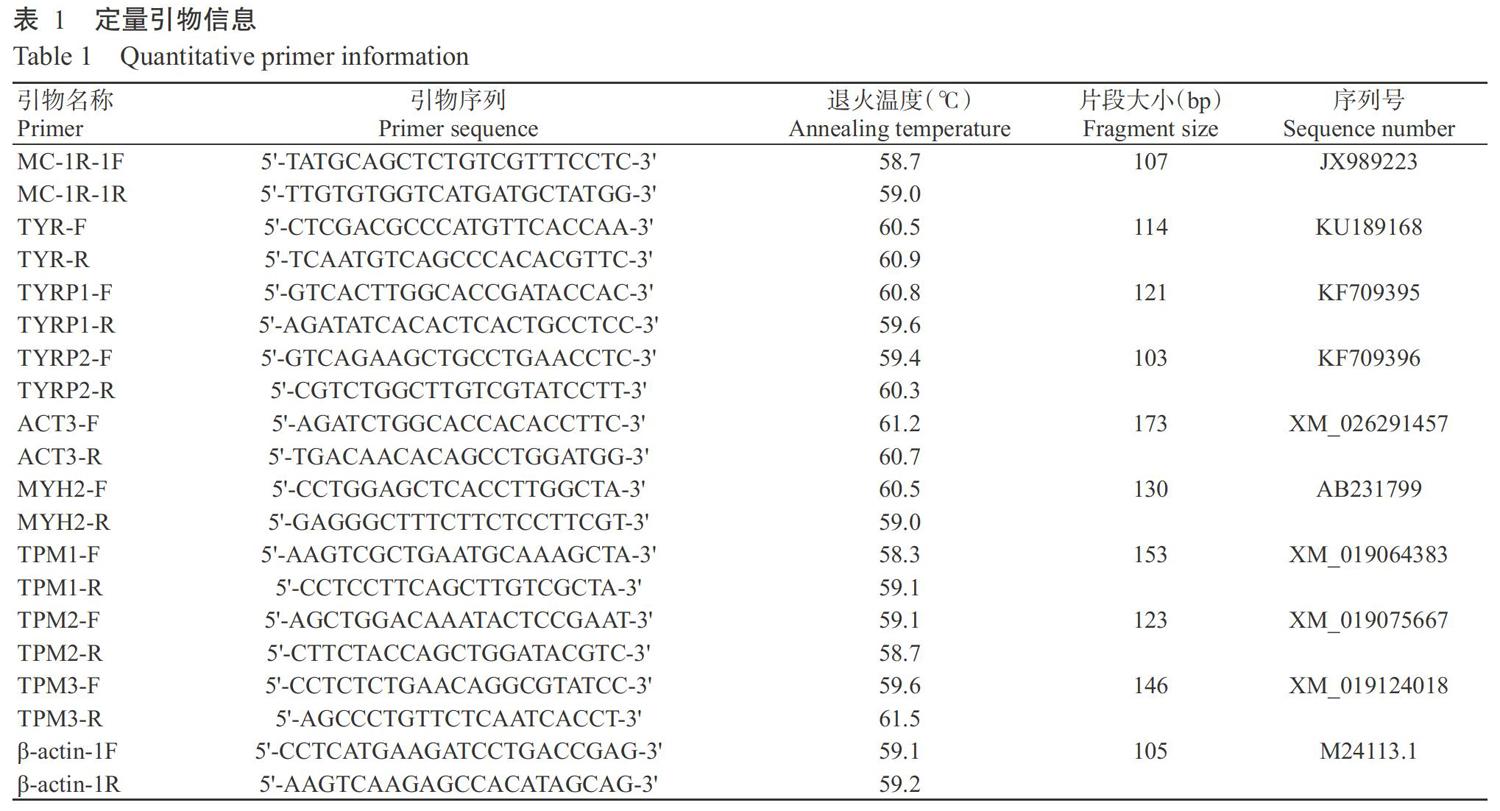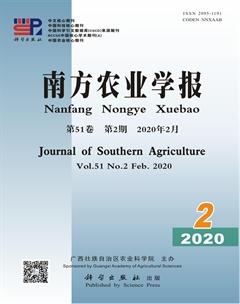金边鲤皮肤黑色素合成及转运相关基因表达分析
韦玲静 吕业坚 邹辉 文衍红 甘宝江 张桂姣 张盛 严雪瑜 叶香尘



摘要:【目的】研究影響金边鲤皮肤色素沉着的关键基因及信号通路,揭示其皮肤颜色差异形成的原因,为金边鲤良种培育提供候选基因信息。【方法】基于突变型金边鲤黄色皮肤(Y组)和黑色皮肤(B组)及野生型金边鲤黑色皮肤(W组)的转录组测序数据,筛选分析获得部分共有差异表达基因,利用实时荧光定量PCR检测差异表达基因和黑色素合成相关基因的表达情况,并分析各基因间的相关性。【结果】依据转录组数据筛选获得ACT3、MYH2、TPM1、TPM2和TPM3共5个来源于心肌肾上腺素信号通路及与细胞动力相关的基因;除ACT3基因外,其余4个基因(MYH2、TPM1、TPM2和TPM3)在Y组皮肤中的相对表达量均显著低于B组和W组(P<0.05,下同),与转录组分析的差异基因表达趋势一致。MC-1R、TYR、TYRP1和TYRP2等4个黑色素合成相关基因在金边鲤皮肤中的表达情况为:B组皮肤中MC-1R基因的相对表达量显著高于Y组和W组;TYR、TYRP1和TYRP2基因在3组皮肤中的相对表达量排序均为W组>B组>Y组,其中W组的相对表达量显著高于B组和Y组。相关性分析结果显示,MC-1R和TYR基因与ACT3、MYH2、TPM1、TPM2和TPM3基因呈显著或极显著(P<0.01)正相关,而TYRP1和TYRP2基因与这5个差异表达基因均无显著相关性(P>0.05)。【结论】ACT3、MYH2、TPM1、TPM2和TPM3基因及其所在的心肌肾上腺素信号通路可能影响黑色素合成与运动,且与黑色素合成相关基因存在相关性,可作为金边鲤体色变异研究中的标记基因。
关键词: 金边鲤;黑色素;差异表达基因;黑色素合成相关基因;心肌肾上腺素通路;色素沉着
中图分类号: S965.116 文献标志码: A 文章编号:2095-1191(2020)02-0453-08
Skin melanin synthesis of Jinbian carp and expression analysis of transport related genes
WEI Ling-jing1, LYU Ye-jian1, ZOU Hui1, WEN Yan-hong2, GAN Bao-jiang1,
Zhang Gui-jiao3, ZHANG Sheng1, YAN Xue-yu1, YE Xiang-chen1*
(1Aquatic Species Introduction and Breeding Center of Guangxi, Nanning 530031, China; 2Liuzhou Aquaculture Technology Extending Station, Liuzhou,Guangxi 545066, China; 3Aquaculture Technology Extension Station of Rongshui County, Rongshui, Guangxi 545300, China)
Abstract:【Objective】The key genes and signaling pathways affecting skin pigmentation of Jinbian carp were stu-died, to reveal the causes of skin color variation mechanism and provide candidate gene information for further cultivating new varieties of Jinbian carp. 【Method】Part of differentially co-expressed genes were screened based on the transcriptome sequencing data of yellow skin(group Y) and black skin(group B) in mutant type, and black skin (group W) in wild type of Jinbian carp, thenreal-time fluorescence quantitative PCR was used to detect the expressions of co-differentially expressed genes and genes related to melanin synthesis, and the correlations among the genes were analyzed. 【Result】A total of five genes,including ACT3, MYH2, TPM1, TPM2 and TPM3, were derived from the adrenergic signaling in cardiomyocytes pathways and associated with cell power were screened according to the transcriptome data.Apart from ACT3, the mRNA expression levels of the other fourgenes(MYH2, TPM1, TPM2 and TPM3) in group Y were all significantly lower than group B and group W(P<0.05, the same below), which was consistent with the trend of the result in transcriptome analysis. The mRNA expression levels of four genesrelating to melanin synthetic, including MC-1R, TYR, TYRP1 and TYRP2 were detected,which showed that the relative expression of MC-1R gene in group B was significantly higher than group Y and group W. The expression of TYR, TYRP1 and TYRP2 in the skin of the three groups showed an order of group W>group B>group Y, in which group W was significantly higher than group B and group Y. Correlation ana-lysis showed that the mRNA expressions levels of MC-1R and TYR gene were significantor extremely(P<0.01) positively correlated with ACT3, MYH2, TPM1, TPM2 and TPM3 genes, while TYRP1 and TYRP2 had no significant correlation with the fivegenes(P>0.05). 【conclusion】ACT3, MYH2, TPM1, TPM2 and TPM3 genes and their adrenergic signaling in cardiomyocytes pathways may affect the synthesis and movement of melanin, which may be related to the skin color variation of the Jinbian carp. These genes can be used as marker genes in the study of skin color variation of Jinbian carp.
Key words: Jinbian carp; melanin; differentially expressed genes(DEGs); melanin synthesis related genes; adrener-gic signaling in cardiomyocytes pathways; pigmentation
Foundation item: Special Project of National Staple Freshwater Fish Industry Technology System Construction(CARS-45)
0 引言
【研究意义】色素是由色素细胞合成的生物高分子化合物,在细胞骨架微管和微丝的作用下,色素颗粒通过聚集或分散作用而影响鱼类体色(谭玉文等,2008)。目前已发现的鱼类色素细胞有5种,包括黑色素细胞、红/黄色素细胞、白色素细胞、虹彩细胞和蓝色素细胞(Kelsh,2010)。其中由神经脊细胞分化而来的黑色素细胞在鱼体中分布最广泛,能合成分泌具有抗辐射、抗氧化及免疫调节等功能的真黑素和褐黑素(Parichy et al.,2007;Geng et al.,2010;邹宇等,2012)。鱼类体色除了反映鱼体的生理健康状况外,还直接影响其市场价格。因此,研究鱼类体色变异的分子机制,对提高鱼类体色遗传稳定性及其经济价值具有重要意义。【前人研究进展】大量研究证实,MC-1R(Melanocortin-1 receptor,黑色素皮质1受体)、TYR(Tyrosinase,酪氨酸酶)、TYRP1(Tyrosinase-related protein 1,酪氨酸相关蛋白1)、TYRP2(Tyrosinase-related protein 2,酪氨酸相关蛋白2)、ASIP(Agouti signaling protein,刺鼠信号蛋白)、MITF(Microphthalmia-associated transcription factor,小眼辅助转录因子)和SOX10(SRY-related HMG-box,Y染色体性别决定基因相关转录因子10)等基因在黑色素合成过程中发挥重要作用(Masca-renhas et al.,2010;Miao et al.,2010;李康乐,2014;徐莹,2014)。相对于其他脊椎动物,鱼类拥有更复杂且多样化的色素沉积方式,受多个基因及信号通路调控。目前,关于鱼类机体色素沉积的研究已有较多报道。Jiang等(2014)基于转录组分析兴国红鲤和黄河鲤皮肤组织时发现,鲤鱼皮肤色素沉积与黑色素合成、Wnt信号通路及MAPK信号通路有关;McCauley等(2004)研究发现Oca2基因部分缺失及MC-1R基因突变能引起墨西哥丽脂鲤体色变异;肖颖琦(2017)认为MAPK信号通路中的dusp6、hsp27、map2k4和mef2c基因与玫瑰高原鳅体色白化有关。原肌球蛋白(Tropomyosin,TMs)被认为是肌球蛋白(Myosin)的稳定蛋白,是一种高度保守和多样化的肌动蛋白家族,可调节肌球蛋白的动力学和结构特性,几乎存在于所有的动物机体内(Lehman et al.,2009)。原肌球蛋白的编码基因(TPM)包含TPM1、TPM2、TPM3和TPM4共4种亚型,TPM基因受损或缺失将导致细胞恶性转化,形成肿瘤或产生畸形,如食管鳞癌、直肠癌和足内翻非综合征等(赵秀丽,2006;赵月鸣,2015;Weymouth et al.,2016)。肌球蛋白是动物肌肉的主要构成蛋白,而肌球蛋白重链(Myosin heavy chain,MYH)是肌球蛋白的组成单位,在非肌肉细胞中发挥细胞骨架的作用,同时参与细胞物质运输、能量代谢及信号传导等途径。黑素体从黑色素細胞转移到树突,再传递给周围角质形成细胞的过程均依赖于细胞骨架中肌动蛋白(Actin)和肌球蛋白等提供动力(Hara et al.,2000)。肌动蛋白在黑色素细胞树突的远端聚集,作为黑素体运输马达,其中肌球蛋白5a(MYO5A)可与黑素亲和素(MLPH)及GTP结合蛋白(Rab27a)结合形成黑色素转运复合体,将黑素体转运至树突末端,终止黑素体在树突中的双向长距离运动(Matesic et al.,2001;Fontanesi et al.,2014)。Wu等(1998)研究发现,肌球蛋白基因突变会导致小鼠毛发颜色变浅,究其原因是黑素体运输受损而聚集在细胞核周区。Hara等(2000)研究表明,细胞骨架成分和微管相关动力蛋白参与黑色素在角质形成细胞内的分布及运动,且动力蛋白与黑素体存在共区域化。【本研究切入点】金边鲤是针对稻田养殖而选育出的鲤鱼新选系,其外形特点为背鳍两侧有能稳定遗传的金色条带。本课题组前期在金边鲤皮肤转录组的研究中富集到与肌球蛋白和肌动蛋白有关的差异表达基因(Yan et al.,2019),但目前金边鲤皮肤变异的分子机制尚未清楚。【拟解决的关键问题】测定肌动蛋白3基因(ACT3)、肌球蛋白重链2基因(MYH2)、原肌球蛋白3个亚型基因(TPM1、TPM2和TPM3)及黑色素合成相关基因(MC-1R、TYR、TYRP1和TYRP2)在金边鲤不同皮肤中的表达情况,并分析其相关性,旨在探究金边鲤皮肤颜色差异形成的原因,为其良种培育提供候选基因信息。
1 材料与方法
1. 1 试验材料
供试鲤鱼取自广西融水县融荣水产繁殖场(同一养殖池塘),分为有金边和无金边的鲤鱼,6月龄,体质量65.17±12.90 g/尾,体长14.35±0.91 cm。采集8尾突变型金边鲤鱼背部的黄色皮肤和黑色皮肤,分别记为Y组和B组;同时采集8尾野生型金边鲤鱼背部的黑色皮肤,记为W组(图1)。样品存于2 mL的冻存管中,以液氮速冻后转入-80 ℃冰箱保存备用。
1. 2 总RNA提取及cDNA合成
3. 2 肾上腺素信号通路在色素沉着中的作用
色素细胞膜上通常分布有细小的肌纤维和神经末梢。色素细胞在肌纤维的收缩牵引下改变形态,促使色素颗粒在驱力蛋白的作用下运动,进而分散或聚集在机体各部位,是鱼类体色变化的主要原因。多巴(Levodopa)是黑色素合成的中间产物,其常见代谢途径是被TYR多次催化形成多巴醌(Dopaquinone),最終氧化形成黑色素(Hearing,2011)。多巴的另一代谢途径是形成儿茶酚胺,儿茶酚胺在相应的转移酶作用下可转化为多巴胺(Dopamine)、去甲肾上腺素(Noradrenaline,NE)和肾上腺素(Adrena-line,AD)(余鹏程,2017)。已有研究证明,黑色素细胞上存在β肾上腺素受体,且AD负责黑色素颗粒的扩散,使动物体色变深;NE负责黑色素团内色素聚集而使动物体色变浅,均属于神经调控体色变化范畴(Fujii,2000;Sivamani et al.,2009)。肾上腺素能受体(Adrenergic receptor,AR)属于G蛋白偶联受体,是儿茶酚胺类物质作用的受体蛋白,可分为α1、α2、β1和β2等4个亚型(Gillbro et al.,2004;Li et al.,2004)。β1-AR能增加细胞内的Ca2+浓度,β2-AR可刺激腺苷酸环化酶(cAMP),与黑色素合成的关键步骤相似。β1-AR拮抗剂会抑制白色素细胞色素颗粒扩散,但对黑色素细胞无影响;β2-AR介导AD抑制黑色素聚集;α2-AR激动剂能调控黑色素细胞和红色素细胞的色素合成,同时通过介导NE引起黑色素颗粒聚集,且对黑色素细胞凋亡有影响(Fujii,2000)。Chou等(1989)认为AD诱导黑色素聚集的信号转导系统第二信使并不是cGMP和cAMP,也不是通过Ca2+信号通路,而是存在一个未知的第二信使。余鹏程(2017)认为β2-AR通过G蛋白—腺苷酸环化酶—蛋白激酶A(GS-AC-PKA)信号通路调节TYR活性或增加其相关基因(TYR、TYRP和TYRP2等)的表达量,从而影响黑色素生成。
本研究在金边鲤皮肤转录组富集到的ACT3、MYH2、TPM1、TPM2和TPM3等5个差异表达基因均来源于肾上腺素信号通路(Adrenergic signaling in cardiomyocytes)。在心肌肾上腺素信号通路中,AD与β1-AR或β2-AR受体结合活化Gs蛋白,激活腺苷酸环化酶(AC),影响第二信使cAMP浓度,随后激活蛋白激酶A系统(PKA)和Ca2+信号通路,最终影响ACT3、TPM和MYH2基因的表达,与余鹏程(2017)认为β2-AR通过GS-AC-PKA通路调节黑色素生成的结论一致。孙福亮(2016)在新吉细毛羊和小尾寒羊皮肤转录分析中同样富集到TPM1、TPM2等与心肌收缩和心肌肾上腺素信号通路相关的差异表达基因。本研究富集到的ACT3、MYH和TPM等基因家族均与黑色素运动的驱动蛋白有关,且除了ACT3基因外,其余4个基因在金边鲤黄色皮肤中的表达量均显著低于黑色皮肤,且与MC-1R和TYR基因表达呈显著或极显著相关,推测这些基因是通过心肌肾上腺素信号通路影响金边鲤皮肤黑色素合成或转运途径,最终影响金边鲤皮肤色素沉着。但究竟是TPM、MYH2、Actins等基因表达差异影响黑色素颗粒运动而导致金边鲤皮肤颜色差异,还是金边鲤金色皮肤中黑色素合成途径受阻才影响这些基因的表达,尚有待进一步探究。
4 结论
MC-1R、TYR、TYRP1和TYRP2基因及其所在信号通路可能影响金边鲤金色皮肤形成,但并非主要因素;ACT3、MYH2、TPM1、TPM2和TPM3基因及其所在的心肌肾上腺素信号通路可能通过影响黑色素合成和运动,是金边鲤体色变异的主要影响因素。ACT3、MYH2、TPM1、TPM2和TPM3基因与黑色素合成相关基因存在相关性,可作为金边鲤体色变异研究中的标记基因。
参考文献:
陈兴婷. 2016. 三种不同品系红罗非鱼耐寒性能比较以及体色相关基因表达分析[D]. 南京:南京农业大学.[Chen X T. 2016. Low temperature resistant performance and six body color relevant genes expression analysis in three red tilapia strain[D]. Nanjing:Nanjing Agriculture University.]
丁颖,邢娅,王倩倩,李文博,刘龙,龚道清,耿拓宇. 2018. TYRP1和MLANA影响朗德鹅羽色形成的机制研究[J]. 中国家禽,40(9):6-10. [Ding Y,Xing Y,Wang Q Q,Li W B,Liu L,Gong D Q,Geng T Y. 2018. Involvement of TYRP1 and MLANA in formation of feather color of Landes goose[J]. China Poultry,40(9):6-10.]
黄睿宇. 2015. 大菱鲆白花斑体色形成生理机制的初步研究[D]. 青岛:中国海洋大学. [Huang R Y. 2015. Preliminary studies of turbot (Scophthalmus maximus) white spotted body color formation physiological mechanism[D]. Qingdao:Ocean University of China.]
李康乐. 2014. 瓯江彩鲤体色相关基因Sox10、Agouti、Tyrp1、Dct的分子克隆与表达分析[D]. 上海:上海海洋大学.[Li K L. 2014. Molecular cloning and expression analysis of pigmentation-related genes,Sox10,Agouti,Tyrp1 and Dct,in Oujiang color common carp,Cyprinus carpio var. Color[D]. Shanghai:Shanghai Ocean University.]
孫福亮. 2016. 新吉细毛羊和小尾寒羊的毛品质性状及皮肤转录组学研究[D]. 延边:延边大学. [Sun F L. 2016. Transcriptomics analysis of skin from XJ and SH by analyzing qualitative character of wool[D]. Yanbian:Yan-bian University.]
谭玉文,孙守荣,朱学农,王鑫玉,曹绣娟,毛华明,邓卫东. 2008. 神经黑色素的研究进展[J]. 中国畜牧兽医,35(7):52-55. [Tan Y W,Sun S R,Zhu X N,Wang X Y,Cao X J,Mao H M,Deng W D. 2008. Research progress of the neuromelanin[J]. China Animal Husbandry and Veterinary Medicine,35(7):52-55.]
肖颖琦. 2017. 玫瑰高原鳅体色白化的遗传学基础研究[D]. 重庆:西南大学. [Xiao Y Q. 2017. Genetic basis of the albinism in the cavefish Triplophysa rosa[D]. Chongqing:Southwest University.]
徐莹. 2014. TYR、TYRP1基因与朝鲜鹌鹑羽色相关性研究[D]. 洛阳:河南科技大学. [Xu Y. 2014. Study on the association of TYR and TYRP1 with plumage color in Ko-rean quails[D]. Luoyang:Henan University of Science and Technology.]
杨竹青,王自蕊,熊六凤,阮记明,隗黎丽. 2014. MC1R基因在中国草金鱼中的遗传变异及其进化分析[J]. 江西农业大学学报,36(5):1122-1126. [Yang Z Q,Wang Z R,Xiong L F,Ruan J M,Wei L L. 2014. A study of genetic variation and evolutional of MC1R gene in Chinese Goldfish[J]. Acta Agriculturae Universitati Jiangxiensis,36(5):1122-1126.]
余鹏程. 2017. β2肾上腺素受体介导酪氨酸促泰和乌骨鸡十二指肠黑色素生成研究[D]. 南昌:江西农业大学. [Yu P C. 2017. β2 adrenergic receptor mediates tyrosine to promote melanin formation in duodenum of Taihe sink fowl[D]. Nanchang:Jiangxi Agriculture University.]
赵秀丽. 2006. 不同肢端畸形中HOXD13、TNNI2和TPM2基因的突变鉴定[D]. 北京:中国协和医科大学. [Zhao X L. 2006. Molecular genetics of limb malformations:Mutation identification in HOXD13,TNNI2 and TPM2[D]. Beijing:Peking Union Medical College.]
赵月鸣. 2015. TPM4在结直肠癌中的表达及其生物学意义[D]. 吉林:吉林大学. [Zhao Y M. 2015. TPM4 expression and biological effect in colorectal cancer[D]. Jilin:Jilin University.]
邹宇,尹冬梅,胡文忠,姜爱丽,陈晨,顾振新. 2012. 天然黑色素理化性质与功能特性研究进展[J]. 食品工业科技,33(24):445-447. [Zou Y,Yin D M,Hu W Z,Jiang A L,Chen C,Gu Z X. 2012. Research progress in physicochemical and functional properties of the natural melanin[J]. Science and Technology of Food Industry,33(24):445-447.]
Chou S C,Taylor J D,Tchen T T. 1989. Epinephrine-induced pigment aggregation in goldfish melanophoroma cells:Apparent involvement of an unknown second messenger[J]. Pigment Cell Research,2(5):414-420.
Cone R D. 2006. Studies on the physiological functions of the melanocortin system[J]. Endocrine Reviews,27(7):736-749.
Fontanesi L,Scotti E,Allain D,Dall'Olio S. 2014. A frameshift mutation in the melanophilin gene causes the dilute coat colour in rabbit (Oryctolagus cuniculus) breeds[J].Animal Genetics,45(2):248-255.
Fujii R. 2000. The regulation of motile activity in fish chromatophores[J]. Pigment Cell Research,13(5):300-319.
Geng J,Tang W,Wan X,Zhou Q,Wang X J,Shen P,Lei T C,Chen X D. 2010. Photoprotection of bacterial-derived melanin against ultraviolet A-induced cell death and its potential application as an active sunscreen[J]. Journal of the European Academy of Dermatology & Venereology,22(7):852-858.
Gillbro J M,Marles L K,Hibberts N A,Schallreuter K U. 2004. Autocrine catecholamine biosynthesis and the beta-adrenoceptor signal promote pigmentation in human epidermal melanocytes[J]. The Journal of Investigative Dermatology,123(2):346-353.
Gross J B,Borowsky R,Tabin C J. 2009. A novel role for MCLR in the parallel evolution of depigmentation in independent populations of the cavefish Astyanax mexicanus[J]. PLoS Genetics,5(1):e1000326.
Hara M,Yaar M,Byers H R,Goukassian D,Fine R E,Gonsalves J,Gilchrest B A. 2000. Kinesin participates in melanosomal movement along melanocyte dendrites[J]. Journal of Investigative Dermatology,114(3):438-443.
Hearing V J. 2011. Determination of melanin synthetic pathways[J]. Journal of Investigative Dermatology,131(S3):E8-E11.
Jiang Y,Zhang S,Xu J,Feng J,Mahboob S,Al-Ghanim K A,Sun X,Xu P. 2014. Comparative transcriptome analysis reveals the genetic basis of skin color variation in common carp[J]. PLoS One,9(9):e108200.
Kelsh R N. 2010. Genetics and evolution of pigment patterns in fish[J]. Pigment Cell Research,17(4):326-336.
Lehman W,Galińska-Rakoczy A,Hatch V,Tobacman L S,Craig R. 2009. Structural basis for the activation of muscle contraction by troponin and tropomyosin[J]. Journal of Molecular Biology,388(4):673-681.
Li F,De Godoy M,Rattan S. 2004. Role of adenylate and guanylate cyclases in beta1-,beta2-,and beta3-adrenoceptor-mediated relaxation of internal anal sphincter smooth muscle[J]. The Journal of Pharmacology and Experimental Therapeutics,308(3):1111-1120.
Mascarenhas J B,Littlejohn E L,Wolsky R J,Young K P,Nelson M,Salgia R,Lang D. 2010. PAX3 and SOX10 activate MET receptor expression in melanoma[J]. Pigment Cell & Melanoma Research,23(2):225-237.
Matesic L E,Yip R,Reuss A E,Swing D A,O'Sullivan T N,Fletcher C F,Copeland N G,Jenkins N A. 2001. Mutations in Mlph,encoding a member of the Rab effector family,cause the melanosome transport defects observed in leaden mice[J]. Proceedings of the National Academy of Sciences of the United States of America,98(18):10238-10243.
McCauley D W,Hixon E,Jeffery W R. 2004. Evolution of pigment cell regression in the cavefish Astyanax:A late step in melanogenesis[J].Evolution & Development,6(4):209-218.
Miao Y,Wu G,Wang L,Li D,Tang S,Liang J,Mao H,Luo H,Zhang Y. 2010. The role of MC1R gene in buffalo coat color[J]. Science China. Life Sciences,53(2):267-272.
Parichy D M,Reedy M V,Erickson C A. 2007. Regulation of melanoblast migration and differentiation[M]. The 2nd Edition. The Pigmentary System:Physiology and Pathophy-siology.
Richardson J,Lundegaard P R,Reynolds N L,Dorin J R,Porteous D J,Jackson I J,Patton E E. 2008. MC1R pathway regulation of zebrafish melanosome dispersion[J]. Zebra-fish,5(4):289-295.
Sivamani R K,Pullar C E,Manabat-Hidalgo C G,Rocke D M,Carlsen R C,Greenhalgh D G,Isseroff R R. 2009. Stress-mediated increases in systemic and local epinephrine impair skin wound healing:Potential new indication for beta blockers[J]. PLoS Medicine,6(1):e12.
Vavricka C J,Christensen B M,Li J Y. 2010. Melanization in living organisms:A perspective of species evolution[J]. Protein & Cell,1(9):830-841.
Weymouth K S,Blanton S H,Powell T,Patel C V,Savill S A,Hecht J T. 2016. Functional assessment of clubfoot associated HOXA9,TPM1,and TPM2 variants suggests a potential gene regulation mechanism[J].Clinical Orthopaedics and Related Research,474(7):1726-1735.
Wu X,Bowers B,Rao K,Wei Q,Hammer J A. 1998. Visuali-zation of melanosome dynamics within wild-type and dilute melanocytes suggests a paradigm for myosin V function in vivo[J]. The Journal of Cell Biology,143(7):1899-1918.
Yan X Y,Wei L J,Huang J,Wang J B,Yang Z S,Gan B J,Liu K,Teng Z Z,Zhang S,Ye X C. 2019. Comparative skin transcriptome between common carp and the variety Jinbian carp(Cyprinus carpio v. Jinbian)[J]. Aquaculture Research,51(1):187-196.

